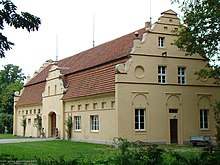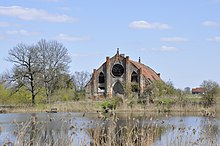Stables




Marstall (from Old High German marahstal , composed of marah 'horse (mare)' and stal ' stable ') was originally a name for a prince's horse stable. In today's parlance, the term Marstall is used for stable constructions of castles and manor houses , which were executed in representative architecture from the early modern period to the 19th century. The term can also denote the totality of all horses of a prince.
Building and organization
The princely stables included the buildings for horses , wagons , carriages and dishes . Depending on the size of the property, Marstall can take on considerable proportions and form their own building complex . Especially in the Baroque period , the stables were lavishly executed. A covered was connected to the royal stables often riding hall (contemporary as Reithaus called) for the Riding School .
The royal stables were usually headed by a high, noble official of the court. In the hierarchy of court posts, he was mostly placed between ranks 4 and 8. Often this task was a representation activity; the actual daily work was incumbent on non-aristocratic leaders. The designation of the position varies: “ Marstaller ” (Württemberg), “Oberstallmeister”, “Oberststallmeister” or “Großstallmeister” were common.
Other names
In Austria, the name Marstall for the former court stables in Vienna (which today form the MuseumsQuartier) is not common, but occasionally for the prince-archbishop's court stables in Salzburg (today the festival halls).
A building comparable to the Royal Stables in the Netherlands are the Royal Stables in The Hague , in Great Britain the Royal Mews in London.
Todays use
Numerous historical royal stables in Germany were converted for a new use from the 19th and 20th centuries after their original function as part of a princely court was no longer applicable. Representative architecture, building size and central location made the buildings particularly suitable as a seat for public institutions. Today, archives , libraries or authorities can often be found in the converted stables. Based on their earlier function, some of these converted buildings have retained the name Marstall. The original use as a horse stable can be viewed, for example, in the Princely Riding School in Bückeburg.
- Marstall in Berg, is used as an event hall as well as for living and business rooms.
- Old and New Marstall in Berlin, used by the Berlin City Library , among others .
- Marstall in Darmstadt , is used as the service building of the Hessian construction management.
- Marstall in Freising , houses the cathedral library Freising
- Marstall Greiz , houses the office for building construction of the district office Greiz.
- Hofmarställe am Hohen Ufer in Hanover as a building complex, of which individual preserved buildings are used as commercial and office buildings.
- Heidelberg Marstall , houses facilities of the University of Heidelberg .
- Kassel Marstall , serves as a market hall and as the seat of the Kassel city archive .
- Marstall in Kempten , houses various museums
- Lübeck Marstall , today a youth center. In contrast to the royal stables, the Lübeck stables was a municipal institution that was headed by two councilors.
- Meininger Marstall , home of a riding club and some offices of the city administration.
- Munich Marstall , with the theater in the Marstall . The older Munich Marstall is the Alte Münze , which was converted into a mint at the beginning of the 19th century and has housed the Bavarian State Office for Monument Preservation since 1989 .
- The Marstall im Thurn und Taxis Castle St. Emmeram in Regensburg is now part of the Castle Museum
- The Schwerin Marstall is now the seat of the Ministries for Social Affairs and Education of Mecklenburg-Western Pomerania, from 1997 to 2011 it also served as the seat of the Technical State Museum .
- Marstall in Weimar, seat of the Thuringian main state archive in Weimar .
- The salt house in Zittau originally served as a warehouse, stables and armory at the same time . Today the building houses, among other things, city authorities, shops, restaurants and a library.
- Marstall in Coburg , service building of the Coburg land surveying office.
- The former electoral stables in Mainz, now known as the Golden Ross barracks , was misused as early as the 18th century and later served as a theater building and barracks, for example. Today the building belongs to the Landesmuseum Mainz .
- The Marstall in Marburg now serves as the residence of the Hessian Scholarship Institution .
- The Potsdam Marstall now houses the Potsdam Film Museum .
- The Marstall of Weilburg Castle is now used as a castle hotel and restaurant.
- The Marstall in Rotenburg an der Fulda is today the seat of the training and further education center of Hessen Mobil - road and traffic management .
- The first Dresden Marstall - a splendid Renaissance building on the Jüdenhof - was structurally changed several times; many architectural elements that indicate its original use are still recognizable today. On the courtyard side of the building there is still a horse pond and a riding ramp on the first floor. The stable building was built from 1586 to 1590 in the Renaissance style and has since been directly connected to the Georgenbau of the residential palace via the long corridor of the stable yard. The building originally served to accommodate the electoral horses and carriages on the ground floor. The electoral armory and harness chamber was on the upper floor. After renovations in the Baroque style, the picture gallery moved into the upper floor in 1747. Another fundamental renovation of the building took place between 1872 and 1876. Since then it has been known as the Johanneum and, after various museum uses, is now used by the Municipal Transport Museum.
- The conversion of the first Dresden Marstall to a picture gallery made it necessary to build a new Royal Marstall . This was built between 1745 and 1748 as a baroque four-winged stable in the Wilsdruffer suburb. It was partially destroyed in the air raids on Dresden in February 1945. The building, which was rebuilt after 1950, was integrated into the theater workshops of the Schauspielhaus.
- Marstall Berlin Wannsee is used by the Social Pedagogical Training Institute Berlin-Brandenburg as a seminar room and dining room.
- The gallery in the Marstall Ahrensburg is an exhibition house for contemporary art and is located in the former Marstall of Ahrensburg Castle.
- The Marstall, located in Drogosze and belonging to Dönhoffstädt Castle, seems to have fallen into disrepair.
Historic stables
- The Marstall built in 1532 in Münstermaifeld in the Mayen-Koblenz district (Rhineland-Palatinate) burned down on February 1, 1914.
- The Marstall in Leipzig , built in 1575, was demolished in 1867.
See also
literature
- Giles Worsley: The British stable. Yale University Press, New Haven CT et al. a. 2004, ISBN 0-300-10708-0 .
- Wolfgang Götz: German baroque stables. Deutscher Kunstverlag, Munich a. a. 1964 ( Art History Studies 34, ISSN 0170-9186 ).
Web links
- The Marstall in Weimar A grand ducal complex in the oldest settlement area of the city - by Andreas Werner
Individual evidence
- ^ Homepage Ministry of Education MV ( Memento from March 24, 2008 in the Internet Archive ); Homepage Ministry of Social Affairs MV ( Memento from March 24, 2008 in the Internet Archive )
- ↑ weilburg-lahn.info



